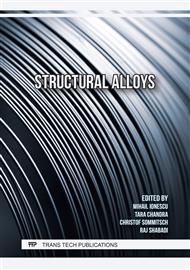[1]
W.S. Miller, L. Zhuang, J. Bottema, et al., Recent development in aluminium alloys for the automotive industry, Materials Science and Engineering: A 280(1) (2000) 37-49.
DOI: 10.1016/s0921-5093(99)00653-x
Google Scholar
[2]
P. Dong, H. Li, D. Sun, et al., Effects of welding speed on the microstructure and hardness in friction stir welding joints of 6005A-T6 aluminum alloy, Materials & Design 45(2013) 524-531.
DOI: 10.1016/j.matdes.2012.09.040
Google Scholar
[3]
M. Werinos, H. Antrekowitsch, T. Ebner, et al., Hardening of Al–Mg–Si alloys: Effect of trace elements and prolonged natural aging, Materials & Design 107 (2016) 257-268.
DOI: 10.1016/j.matdes.2016.06.014
Google Scholar
[4]
E.A. Marquis, D.N. Seidman, Nanoscale structural evolution of Al3Sc precipitates in Al(Sc) alloys, Acta Materialia 49(11) (2001) 1909-1919.
DOI: 10.1016/s1359-6454(01)00116-1
Google Scholar
[5]
S.P. Wen, K.Y. Gao, Y. Li, et al., Synergetic effect of Er and Zr on the precipitation hardening of Al–Er–Zr alloy, Scripta Materialia 65(7) (2011) 592-595.
DOI: 10.1016/j.scriptamat.2011.06.033
Google Scholar
[6]
H. Li, J. Bin, J. Liu, et al., Precipitation evolution and coarsening resistance at 400°C of Al microalloyed with Zr and Er, Scripta Materialia 67(1) (2012) 73-76.
DOI: 10.1016/j.scriptamat.2012.03.026
Google Scholar
[7]
H. Li, Z. Gao, H. Yin, et al., Effects of Er and Zr additions on precipitation and recrystallization of pure aluminum, Scripta Materialia 68(1) (2013) 59-62.
DOI: 10.1016/j.scriptamat.2012.09.026
Google Scholar
[8]
A.Y. Algendy, K. Liu, P. Rometsch, et al., Effects of AlMn dispersoids and Al3(Sc,Zr) precipitates on the microstructure and ambient/elevated-temperature mechanical properties of hot-rolled AA5083 alloys, Materials Science and Engineering: A 855 (2022) 143950.
DOI: 10.1016/j.msea.2022.143950
Google Scholar
[9]
C.B. Fuller, J.L. Murray, D.N. Seidman, Temporal evolution of the nanostructure of Al(Sc,Zr) alloys: Part I – Chemical compositions of Al3(Sc1−xZrx) precipitates, Acta Materialia 53(20) (2005) 5401-5413.
DOI: 10.1016/j.actamat.2005.08.016
Google Scholar
[10]
K. Liu, H. Ma, X.G. Chen, Enhanced elevated-temperature properties via Mo addition in Al-Mn-Mg 3004 alloy, Journal of Alloys and Compounds 694 (2017) 354-365.
DOI: 10.1016/j.jallcom.2016.10.005
Google Scholar
[11]
R.A. Karnesky, M.E. van Dalen, D.C. Dunand, et al., Effects of substituting rare-earth elements for scandium in a precipitation-strengthened Al–0.08at. %Sc alloy, Scripta Materialia 55(5) (2006) 437-440.
DOI: 10.1016/j.scriptamat.2006.05.021
Google Scholar
[12]
S.P. Wen, K.Y. Gao, H. Huang, et al., Precipitation evolution in Al–Er–Zr alloys during aging at elevated temperature, Journal of Alloys and Compounds 574 (2013) 92-97.
DOI: 10.1016/j.jallcom.2013.03.237
Google Scholar
[13]
A. De Luca, S. Shu, D.N. Seidman, Effect of microadditions of Mn and Mo on dual L12- and α-precipitation in a dilute Al-Zr-Sc-Er-Si alloy, Materials Characterization 169 (2020) 110585.
DOI: 10.1016/j.matchar.2020.110585
Google Scholar
[14]
J. Rakhmonov, K. Liu, P. Rometsch, et al., Effects of Al(MnFe)Si dispersoids with different sizes and number densities on microstructure and ambient/elevated-temperature mechanical properties of extruded Al–Mg–Si AA6082 alloys with varying Mn content, Journal of Alloys and Compounds 861 (2021) 157937.
DOI: 10.1016/j.jallcom.2020.157937
Google Scholar
[15]
F. Liu, X. Zhu, J. Qin, et al., Effect of Mn/Cr ratio on precipitation behaviors of α-Al(FeMnCr)Si dispersoids and mechanical properties of Al–Mg–Si–Cu alloys, Materials Science and Engineering: A (2022) 144269.
DOI: 10.1016/j.msea.2022.144269
Google Scholar
[16]
A.R. Farkoosh, X. Grant Chen, M. Pekguleryuz, Interaction between molybdenum and manganese to form effective dispersoids in an Al–Si–Cu–Mg alloy and their influence on creep resistance, Materials Science and Engineering: A 627 (2015) 127-138.
DOI: 10.1016/j.msea.2014.12.115
Google Scholar
[17]
A. Elasheri, E.M. Elgallad, N. Parson, et al., Evolution of Zr-Bearing Dispersoids during Homogenization and Their Effects on Hot Deformation and Recrystallization Resistance in Al-0.8%Mg-1.0%Si Alloy, Journal of Materials Engineering and Performance (2021).
DOI: 10.1007/s11665-021-05917-8
Google Scholar
[18]
V. Hansen, B. Andersson, J.E. Tibballs, et al., Metallurgical reactions in two industrially strip-cast aluminum-manganese alloys, Metallurgical and Materials Transactions B 26(4) (1995) 839-849.
DOI: 10.1007/bf02651731
Google Scholar
[19]
V. Hansen, J. Gjønnes, Quasicrystals in an aluminium alloy matrix and the transformation to α‒AlMnSi via intermediate stages, Philosophical Magazine A 73(4) (1996) 1147-1158.
DOI: 10.1080/01418619608243710
Google Scholar
[20]
T. Ohashi, N. Fukatsu, K. Asai, Crystallization and precipitation structures of quasicrystalline phase in rapidly solidified Al-Mn-X ternary alloys, Journal of Materials Science 24(10) (1989) 3717-3724.
DOI: 10.1007/bf02385762
Google Scholar
[21]
V. Hansen, J. Gjønnes, B. Andersson, Quasicrystals as part of the precipitation sequence in an industrially cast aluminium alloy, Journal of Materials Science Letters 8(7) (1989) 823-826.
DOI: 10.1007/bf01730150
Google Scholar
[22]
A.R. Farkoosh, D.C. Dunand, D.N. Seidman, Enhanced age-hardening response and creep resistance of an Al-0.5Mn-0.3Si (at.%) alloy by Sn inoculation, Acta Materialia 240 (2022) 118344.
DOI: 10.1016/j.actamat.2022.118344
Google Scholar
[23]
A. Mochugovskiy, N. Tabachkova, A. Mikhaylovskaya, Annealing induced precipitation of nanoscale icosahedral quasicrystals in aluminum based alloy, Materials Letters 247 (2019) 200-203.
DOI: 10.1016/j.matlet.2019.03.126
Google Scholar
[24]
F. Zupanič, C. Gspan, J. Burja, et al., Quasicrystalline and L12 precipitates in a microalloyed Al-Mn-Cu alloy, Materials Today Communications 22 (2020).
DOI: 10.1016/j.mtcomm.2019.100809
Google Scholar



